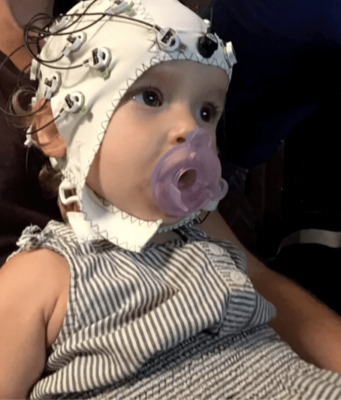This case study delves into the unprecedented occurrence of Dyke-Davidoff-Masson Syndrome (DDMS) in a 10-month-old male child, shedding light on the atypical onset of this neurological disorder during infancy. Initially presented with irritability, loss of appetite, and right-sided weakness following fever episodes, the child’s condition escalated to include generalized tonic-clonic seizures, prompting further investigation. Diagnostic imaging, including CT and MRI scans, confirmed features consistent with DDMS, including cerebral hemiatrophy, ventricular enlargement, and calvarial thickening. Successful seizure management with antiepileptic medication stabilized the child’s vital signs. This case underscores the significance of considering rare neurological disorders in pediatric patients with unusual presentations and highlights the challenges in diagnosing and managing DDMS in infancy. Further research is warranted to elucidate the underlying mechanisms, contributing factors, and optimal management strategies for DDMS in this age group.
Introduction on Dyke-Davidoff-Masson Syndrome
DDMS is an uncommon neurodevelopmental disorder characterized by cerebral hemiatrophy, ventricular enlargement, and calvarial thickening, often accompanied by seizures and hemiparesis 2. While typically reported in older children and adolescents, DDMS rarely occurs in infants, making its manifestation in a 10-month-old child particularly noteworthy 3. The pathogenesis of DDMS is multifaceted, with vascular insult, infection, and trauma implicated as potential factors 3. Cerebral hemiatrophy, a hallmark of DDMS, is believed to result from insults to the developing brain during early childhood. The clinical manifestations of DDMS vary widely, posing challenges to accurate diagnosis, especially in pediatric populations 4.
Case Presentation 1
A 10-month-old male child presented with frequent crying, irritability, loss of appetite, persisting for 15 days, and right-sided weakness over the past month. Two fever episodes at seven months were managed with IV antipyretics and antibiotics, followed by sudden generalized tonic-clonic seizures upon discharge from the local hospital. Physical examination revealed weakness, reduced sensation, and facial asymmetry, prompting admission for further evaluation. CT revealed a left parietal-temporal infarct and subsequent MRI confirmed features consistent with DDMS, including cerebral hemisphere atrophy, ventricular enlargement, calvarial thickening, and frontal sinus hyperpneumatization. The child’s seizures were controlled with antiepileptic medication, leading to stabilized vitals and discharge planning.

Figure 1: Facial asymmetry

Figure 2: Left parietal-temporal infarct with cerebral palsy

Figure 3: Right cerebral hemisphere atrophy, ventricular enlargement, calvarial thickening on the same side, and increased air volume in the right frontal sinus.
Discussion
This case highlights the rarity of DDMS in early infancy and the challenges in diagnosis and management. While DDMS is typically identified in older children, this case underscores the importance of considering rare neurological disorders in pediatric patients with atypical symptoms 4. The etiology of DDMS remains diverse, with infection or inflammatory responses potentially contributing, as observed in this case following fever episodes 3. Advanced imaging techniques, including CT and MRI, are crucial in confirming DDMS diagnosis, aiding differentiation from other conditions. Management involves a multidisciplinary approach, focusing on underlying causes and symptom control, but evidence-based guidelines for infants are lacking, necessitating individualized treatment plans and long-term follow-up 3.
Conclusion 1,2,3,4
In conclusion, this case of DDMS in a 10-month-old child emphasizes the rarity of this disorder in early infancy. The diagnostic journey involved comprehensive evaluation and advanced imaging modalities, highlighting the challenges in diagnosis and management. Successful seizure control underscores the importance of early recognition and intervention. However, the absence of standardized guidelines for infantile DDMS necessitates individualized treatment plans and ongoing follow-up. Continued research is crucial to expand understanding, establish diagnostic criteria, and refine management approaches for DDMS in pediatric patients. Heightened clinical awareness and a multidisciplinary approach are pivotal in navigating this rare neurological disorder.
This case reminds healthcare professionals to remain vigilant and consider rare conditions in pediatric patients, especially when faced with unusual presentations. Additionally, it underscores the importance of further research to deepen our understanding of DDMS and improve outcomes for affected individuals.
References
- Khandelwal R, Vagha JD, Meshram RJ, et al. A Rare Pediatric Neurological Case: Dyke-Davidoff-Masson Syndrome Unprecedented at 10 Months. Cureus. 2024 Jan 29; doi:10.7759/cureus.53168
- Kumar Nv, Gugapriya T, Guru A, et al. Dyke-Davidoff-Masson syndrome. International Journal of Applied and Basic Medical Research. 2016;6(1):57. 10.4103/2229-516X.174016
- Singh P, Saggar K, Ahluwalia A. Dyke-Davidoff-Masson syndrome: Classical imaging findings. Journal of Pediatric Neurosciences. 2010;5(2):124. 10.4103/1817-1745.76108
- Förstl H, Zerfass R, Geiger-Kabisch C, et al. Brain atrophy in normal ageing and Alzheimer’s disease. Volumetric discrimination and clinical correlations. Br J Psychiatry. 1995, 167:739-46. 10.1192/bjp.167.6.739
About Docquity
If you need more confidence and insights to boost careers in healthcare, expanding the network to other healthcare professionals to practice peer-to-peer learning might be the answer. One way to do it is by joining a social platform for healthcare professionals, such as Docquity.
Docquity is an AI-based state-of-the-art private & secure continual learning network of verified doctors, bringing you real-time knowledge from thousands of doctors worldwide. Today, Docquity has over 400,000 doctors spread across six countries in Asia. Meet experts and trusted peers across Asia where you can safely discuss clinical cases, get up-to-date insights from webinars and research journals, and earn CME/CPD credits through certified courses from Docquity Academy. All with the ease of a mobile app available on Android & iOS platforms!







